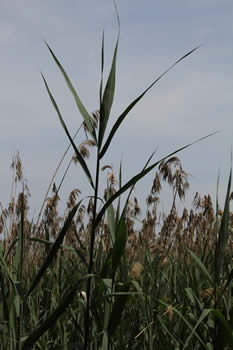Dephragging the Marsh
An alternative proposal to the DEC plan
I hereby call upon all of those in favor of the proposal to spray herbicide in the Piermont marsh to reduce the invasion of phragmites to consider the following alternative plan to restore species diversity in the Sparkill creek watershed. Said citizens, bureaucrats, and scientists should eliminate their lawns by spraying them with roundup and then replace them with native species, including but not limited to grasses, wildflowers and understory shrubs. This plan, which is in many respects similar to the DEC plan, and has many of the same aims, has the following features and benefits. 1. Elimination of a monoculture environment created by the introduction of foreign grasses which is drastically reducing the diversity of native species all over Rockland County. (Let's remember, folks, phragmites is also a grass!) This monoculture environment (lawns) has taken over far greater areas of Rockland than the phragmites has, and must hence be perceived as a much greater threat in any objective scientific analysis. (The DEC plan has not included this particular issue in its analysis of the problems in the marsh.) 2. Reducing the excessive and increasing use of our limited freshwater resources to maintain these objectively unnecessary vanity plantings. (The DEC plan does not address this problem, which is so serious United Water is proposing drastic desalinization solutions to fix it.) 3. Reducing the enormous amounts of pesticide herbicide and fertilizers being used to maintain lawns, all of which drain into the Hudson river through the Sparkill Creek and all the Hudson river tributaries, thereby polluting the river. (The DEC plan does not address this issue.) 4. Increased habitat and foraging space for birds and other wildlife. 5. Reduced maintenance costs for homeowners. (The DEC plan does not feature this direct benefit to homeowners.) The expansion of population and development in the Sparkill creek watershed (and all over the Hudson River valley) has resulted in dramatically increased nitrogen runoff, which is one of the probable causes of the expansion of phragmites in the Piermont Marsh. Getting at the root of this cause ought to have very positive effects. The best news for all citizens who get on board and support this alternative effort to restore biodiversity to Rockland County is that all of it can be achieved on a citizen initiative basis, without spending any taxpayer money whatsoever. (The DEC plan costs millions of dollars.) It also allows those who want to restore the marsh to its original condition to demonstrate the full extent of their commitment by starting at home, and restoring their yard to its original pre-lawn conditions. |
The New York Times article on this subject. So you want to get rid of invasive species?
Ailanthus trees, which grow all over the NY area (immortalized in "a tree grows in Brooklyn"), are an invasive species. So is Paulownia. Efforts to exterminate them would obviously be pointless. Queen Anne's lace, the common wildflower we all grew up with, is from Europe. Starlings are an invasive species. 33% of the common earthworms that we have in the US are invasive species; they were brought from England and have populated the majority of the United States. The list is practically endless. Any attempts to turn the landscape back into what it used to be are based on fantasy and imagination; one has to live with what one has.
While I stand in favor of salt marsh restoration, within the limited parameters and to the extent that it can be accomplished, doing so using herbicides or other chemical means is a fundamentally flawed idea. The chemical assault that is already taking place on our environment is disastrous; our waterways are polluted with tens of thousands of different industrial chemicals, prescription medications, pesticides, herbicides, hormones, organic wastes, and petroleum byproducts, and all of them are affecting each other.
Every single one of these chemicals has the potential to affect cellular interactions, which is the real issue. Over long periods of time, these chemicals can alter the microbial structure of our soils and affect other microorganisms. Not only that, the synergistic effect of all these chemicals coming into contact with each other and interacting is creating situations that it's impossible to analyze in the laboratory — in other words, the only laboratory where anyone is doing any experiments to find out what this will do is in nature, the last place where one wants to conduct such research.
What the average person doesn't understand that it is the microbiology of all of this that will ultimately do us in. We won't see the final results until it is far too late to fix the problem.
The fundamental well-being of plants begins with healthy microbial structure. The microbes around every plant are specific to its own root systems, and exist in powerful symbiosis with them, in exactly the same way our gut bacteria exist within us. Long-term disruption of soil microbiology will have disastrous effects. It hasn't been verified yet, but it's quite possible that a number of the areas in the Middle East which were originally fertile (eg. Ur, Nimrud, etc., circa 1000-2000 BC) were rendered desert because of, among other things, long-term degradation of soil microbiology. The insults delivered to the soils there were cumulative; the fact is that we don't fully understand the long-term effects of intensive agriculture; except that it usually depletes the soils and ruins them. At that point, even with fertilizers, yields will plummet. Just think of the fact that the barren tracts of North Africa were once the place where all the grain that fed the Romans was grown.
Think of this. Every tree's leaves have a specific chemistry, pH (acidity or alkalinity) and they fall around the base of that tree. The microbes, nematodes, and other organisms that support the microscopic root systems around that tree are specifically adapted, over millions of years of evolution — probably hundreds of millions of years — and are exquisitely attuned to the peculiar chemical conditions of that exact soil, which is to some extent (more than likely a large extent) determined by the leaf litter.
This means that the leaf litter from every tree helps support the long-term health of that particular tree. Removing the leaf litter from around the roots of trees is probably, over the course of centuries, a way to destroy your forests, your trees, and your soil, yet no one thinks about it, because nobody realizes that everything we see growing everywhere depends on soil microbiology first, in order to grow at all. This is a dawning realization in the world of biology, which has until recent decades always dedicated itself to macrobiological effects — that is, large things which can be seen by the naked eye. We are now discovering that gut bacteria have a tremendous impact on our own health; things work exactly the same way in the plant world, a fact that is as of yet relatively under-appreciated, but beginning to gain traction. The difficulty that biologists have in communicating this right now is that it appears to be an extremely obscure and supremely uninteresting subject to most people.
When all the trees and plants start dying, it will become very interesting indeed, but I doubt people will enjoy it much. The excursion into an explanation about how leaf litter and pollutants affect microbes around plants may seem like a bit of a side trip, but it's not. Herbicides and pesticides disturb soil microbiology far more than just taking the poor 'ol leaf litter away does. They cause unintended evolution of microbial species. No one knows where that will lead, but it certainly won't be to places we are familiar with. This is why the most conservative approach possible is the correct approach to take.
Pouring chemicals all over the planet is having deleterious long-term effects on the microbiology that supports plant growth. This is a disaster in the making that won't be fully recognized until long after it is too late to reverse it, but it creates by itself a powerful argument to use as few pesticides and herbicides as possible, in fact, to eliminate the need for them wherever possible.
This is why any program that proposes spraying any kind of chemical to "control" a natural area must be opposed, fundamentally.
|
The Hudson River Diaries: Photo essays by the author on the marsh and its surrounding environs |
| My letter to the DEC on spraying in Piermont Marsh |
| Glyphosates and You: Why herbicides with this chemical must not be used. |
| Why gut bacteria are important to you, and why you ought to care a lot. |
| My exchange with the Audubon Society |
| Links on why chemical pollution of waterways is a major issue |
|
|
Nefersweetie an incidental web space created and supervised by Lee van Laer |

